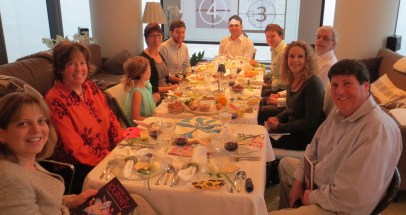Passover Seders in my family were always large affairs. Persons who had no place to go for Seder (“Welcome the stranger…”) and persons of other faiths joined family members in celebrating the liberation of the Jewish people from slavery in Egypt more than three thousand years ago. Whether conducted by my grandfather (mostly in Hebrew), my parents (much more in English) or my father-in-law (a Reform Rabbi who used a healthy mix of Hebrew and English), we joyously celebrated together.

Several years ago, I began to attend a series of programs focusing on interfaith issues for Jewish professionals and lay leaders conducted by the Outreach Training Institute (now Reform Jewish Outreach Boston). After attending panel discussions, workshops and seminars over several years I decided to write a Passover Haggadah for the contemporary Jewish family – which may include members who were born Jewish, those who have chosen to be Jewish, and family members of other faiths. Looking across the spectrum of knowledge, religious practice, and faith – from the observant to those for whom Judaism and Jewish Festivals and traditions were new – my purpose was to create a text for a joyful and inspirational family Seder.
The result of my efforts is Sharing the Journey: The Haggadah for the Contemporary Family published by the Central Conference of American Rabbis Press (CCAR Press). It is illustrated with magnificent original art work by the contemporary Jewish artist Mark Podwal. Sharing the Journey is an inclusive Haggadah that addresses the needs of every family member. For family members and guests who are attending their first Seder or do not know what questions to ask about the observance of Passover, Sharing the Journey explains the meaning of the symbols and rituals of Passover in language that is clear and understandable. For family members whose participation in a Seder is an important religious occasion, Sharing the Journey provides an opportunity to gain a deeper understanding of God’s teachings through the story of the Exodus and to renew and strengthen commitment to the pursuit of freedom, tolerance, and justice. For everyone, Sharing the Journey provides the framework for a joyful and meaningful Passover celebration – enabling all family members to truly experience the power of the Seder and the story of the Exodus: A shared Jewish experience that has historical and contemporary significance to persons of all faiths.
Best wishes from me and the entire Yoffie Family for an inclusive, joyous, and inspirational Passover Seder.
Alan S. Yoffie is a former president of Temple Emanuel in Worcester, MA and an active member of its Jewish community. He currently serves on the Board of Directors of the Worcester Jewish Community Center and The Jewish Healthcare Center and as a member of the Ritual Committee of Congregation B’nai Shalom in Westborough, MA. In addition to Sharing the Journey: The Haggadah for the Contemporary Family, Mr.Yoffie wrote a Seder Leader’s Guide, also available from the CCAR Press, which includes two CDs (instrumental and vocal) that provide a “musical companion” for the Seder.


















